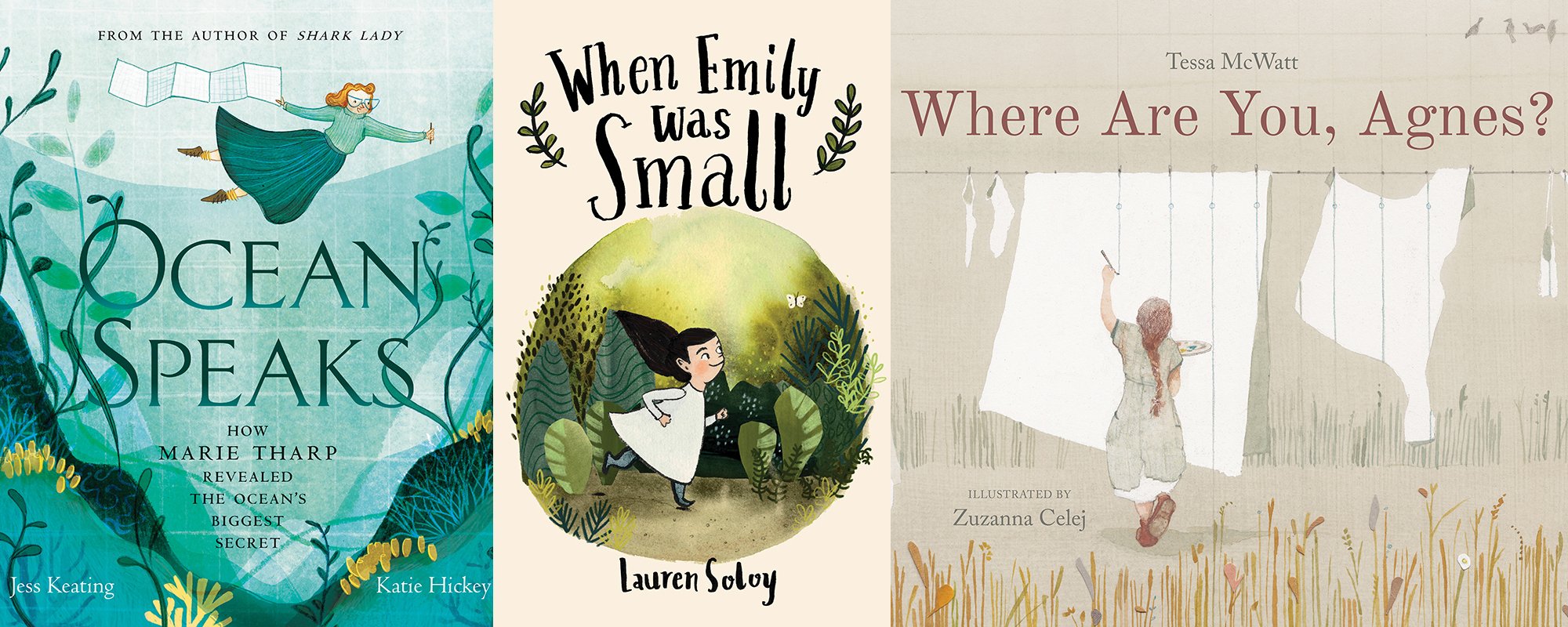 When it comes to the current state of picture books, portrayals of important historical women are in ample supply. Three new titles communicate the impact of their subjects to young readers while taking a fresh approach and a little creative licence, blurring the lines between fact, fiction, and reimagination.
When it comes to the current state of picture books, portrayals of important historical women are in ample supply. Three new titles communicate the impact of their subjects to young readers while taking a fresh approach and a little creative licence, blurring the lines between fact, fiction, and reimagination.
Jess Keating is a kid-friendly triple threat: a zoologist, writer, and cartoonist. Her picture-book biography, Ocean Speaks, tells the story of Marie Tharp, an unsung marine-science heroine who used data to chart a giant rift valley on the floor of the Atlantic Ocean. In the 1950s, sexism forced Tharp to pursue her dreams of undersea exploration from behind a desk, and Keating focuses on Tharp’s resiliency and adaptability, explaining, “She had found another way to follow her dream. With her map, she could be an explorer after all.”
The text espouses curiosity and determination; the Ontario author frames problems as puzzles yet to be solved, and institutional roadblocks as opportunities for more data-driven evidence – both relevant approaches in today’s world and workforce. British artist Katie Hickey’s illustrations blend vibrant, natural hues of blue, green, yellow, and brown with high detail, creating intricate scenes that are best likened to a scientific dollhouse. From the overflowing shelves of Tharp’s childhood home laboratory to a mammoth chalkboard filled with calculations, these are pictures that reward the observant eye, a fitting choice for a book that honours the complexity and beauty of oceanographic cartography. Bonus: don’t miss the surprisingly villainous cameo by Jacques Cousteau.
Ocean Speaks fits neatly into the narrative non-fiction category. When Emily Was Small, a debut by Nova Scotia author-illustrator Lauren Soloy, starts to muddy the waters of categorization. Soloy looks at a day in the life of young Emily Carr, who is most at home in her father’s garden (and no, she will not be heeding her mother’s warnings to keep her dress clean). Soloy captures Carr’s likeness to a tee, particularly the intensity of her scrutinizing gaze and expressive, dark eyebrows.
Soon a wolf, named the Wild, appears and begins to show Emily even more beauty in the world around her. The Wild also bears a striking resemblance to Carr, suggesting that the wolf is actually a part of her that she is just starting to discover. Eventually, the two take flight through a whizzing blur of nature that makes “a deep and vast song, like a wild beating heart of now.”
The text is poetic yet frenetic, pulsing near the point of bursting with natural sights and sounds. It’s a worthy tribute to the movement inherent in Carr’s work, especially her paintings of trees. While flying hand-in-paw with a talking wolf cannot rightly be labelled factual, the essence of Carr is still here, and still true.
Where Are You, Agnes?, a picture book by Guyanese-Canadian writer Tessa McWatt and Polish illustrator Zuzanna Celej, offers an even more speculative look into an artist’s childhood. This is an imagined version of a young Agnes Martin, the renowned abstract painter born in Saskatchewan in 1912. The match between Celej’s colour palette and the book’s subject matter is exquisite. Tones of peach, blue, grey, and yellow are weightless and wan but still teeming with energy. And when Agnes moves to the city, the prairie colours positively burst in comparison to the lifeless grey of the urban environment.
Martin’s work was dominated by vertical and horizontal lines, but Celej does more than just imitate the painter’s style. Opening this book is akin to donning a pair of magic glasses to see the world the way Martin may have; she “tried to follow the lines to see where they would lead her,” writes McWatt. Celej’s pictures actually show the lines overlaying different objects and landscapes in Martin’s mind.
McWatt’s text also posits that much of the artistic process remained a mystery, even to Martin herself. Like abstract art, Where Are You, Agnes? prioritizes a feeling of truth over imparting information, but an author’s note does explain the various liberties taken.
Knowing a person involves so much more than reciting a list of biographical facts about them. These three picture books tell the stories of important women by documenting the known aspects of their outer lives and imagining, in an informed and thoughtful way, what may have been hidden within.
 Contact us via email
Contact us via email

